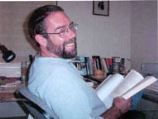Winter 2005, Volume 22.2
Poetry

Rob Stothart
Rob Stothart received an MFA from the University of Washington. His work has appeared in Willow Springs, Southern Humanities Review, The Seattle Review, North Dakota Quarterly, and Bellowing Ark. He is an English instructor at Northwest College in Powell, Wyoming, and lives in Cody, where he first saw Audubon's "Carolina Parrot" at the Buffalo Bill Historical Center.
Still, Vivid Parrot
Seven birds in an airy clutch of twigs—green wings,
yellow heads, thick beaks, ripe husks, broken leaves—
collapsed to a rectangle's two dimension, 1827,
by Robert Havell, engraver of Philadelphia,
after Audubon's own rendering.
The architecture of the whole—
light, color, and substance; one view of nation,
Plate 26 in Birds of America—is pressed
like a lover's blossom between pages in newer context.
Seven Carolina parakeets, parrots in Audubon's day.
He watched flocks descend on brush
like this pernicious, tough-rooted cocklebur
and any other fruit bearing branch or stalk,
wild or domestic. Farmers shot this nuisance
to their labors and gathered baskets
of the brilliant carcasses from which Audubon
could pick and choose as many as he wished
for his picture.
He wired the bones and stuffed the little skins, then
placed them in poses behind a wire grid to translate
his imaginary tableau from space to page.
This group of seven will swoop and perch
for all time. Flared wings, sword-like tails,
the burst of orange in each face, around each
mouth. Each comes raucous to the feast. Each
drops out of summer's expanse. Each revels
in dry splendors of abundant autumn.
Specimen
Usually shelved somewhere back in
the Academy of Natural Sciences
on the Benjamin Franklin Parkway between
Philadelphia's City Hall and the Museum of Art,
this bird was shot by Audubon in 1843, says
the penciled tag trailing off its leg.
He found multitudes of these parrots around Ft. Leavenworth
on his voyage up the Missouri as he traveled first class
on the steamship Omega to paint America's quadrupeds—
a late, second project, Ark-like in scope, to include the buffalo,
the martin, the lynx…all burrowers, grazers, scavengers,
and hunters…all four-legged mammals
who bore their young alive. This in old age
after seeing through Birds of America,
and though birds would stay his first love,
on that trip they were recreation—scientific fancies,
fond remembrances.
He described the flesh of this parrot as "tolerable food."
He noticed tiny mites migrating from the bird's skin
out across its feathers at the moment of death.
He recalled its inarticulate cries and efficient, even acrobatic,
flights through dense eastern and southern woods.
Extinct by the 1930s. Still, this specimen—on loan
with a lazuli bunting, a western meadowlark, and
Audubon's gun—remains vivid in its cloak
of greens and blues, its yellow hood.
From the way its shoulders are gathered inside
the skin, the body looks like a small canoe
or a weaver's shuttle. The eye hollows, packed
with wadding; the claws reach back, closed
in an empty grasp, lying on this glass museum shelf.
And the beak, thick yellow and cracked like
an old man's toenail, curves from the golden head,
and is parted, as if this blind, extinct bird
would speak.
Someone in the Night
I think I wander in my sleep,
skirt houses
and climb high places
searching for light
my father drew in western landscapes.
I fear neighbors might follow,
climb after and find me under
some barn roof where I shoulder
walls of swallows' nests.
His unfinished West would shy from faces,
shrink under curious eyes,
then break away,
a collapsing sun, an overripe plum,
fallen down
some abandoned mineshaft
where light bruises through skin
and spills out over
black-faceted walls.
